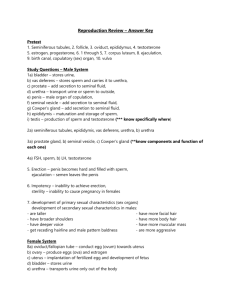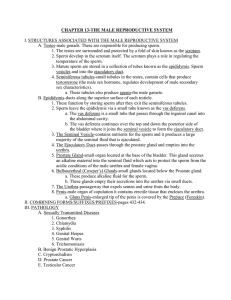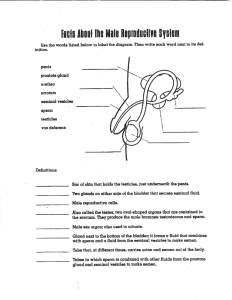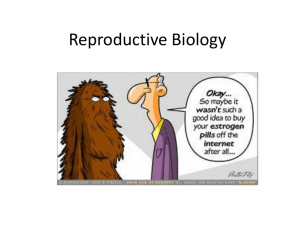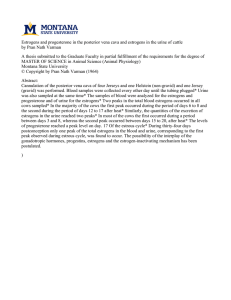Reproductive System
advertisement
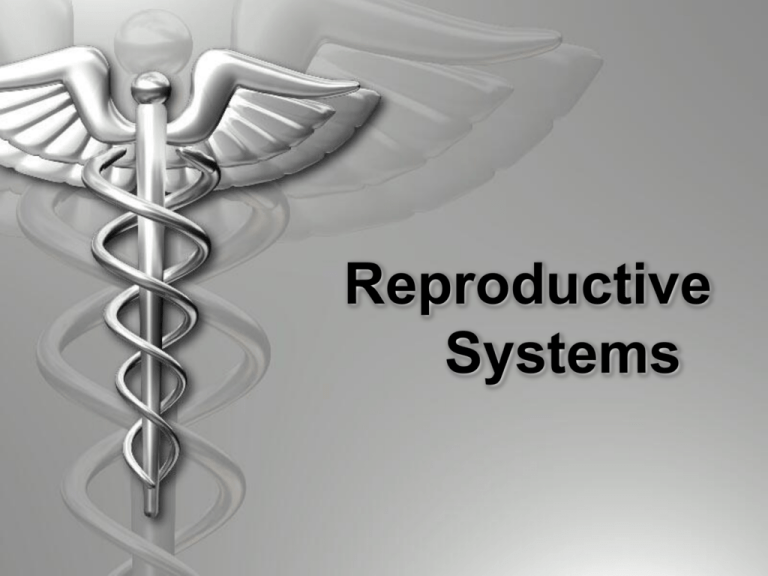
Reproductive Systems I. Male or Female? Function is to produce and deliver sperm I H A B C D G F E A. Testes 1. Each of the testes is made up of many seminiferous tubules What process occurs here? 2. Sperm form inside the tubules 3. Interstitial cells lie between the seminiferous tubules and produce testosterone What is the scrotum and what is its function? seminiferous tubules Testes B. Structure of Sperm Cells 1. A sperm cell has a head containing the haploid nucleus, a mid-piece containing mitochondria, and a tail that is a flagellum. 2. At the tip of the head is the acrosome which contains species specific enzymes. What do these enzymes do? C. Vas Deferens (ductus deferens) 1. Carries sperm from testes to ejaculatory duct. Vas deferens 2. It passes through the body wall via the inguinal canal. What is an inguinal hernia? What is a vasectomy? D. Ejaculatory Duct 1. Forces semen into urethra E. Urethra 1. Carries semen through the Urethra penis to the outside of the body. 2. Special valve prevents urine from entering the urethra when penis is erect F. Penis 1. Soft tissue that fills with blood Function? Ejaculatory Duct G. Seminal Vesicles 1. Produces seminal fluid Seminal Vesicle H. Prostate Gland 1. The prostate gland is a chestnut-shaped structure that also forms seminal fluids 2. Most older men develop prostate problems Prostate Gland Internal Organs of the Male System Urinary bladder Seminal vesicle Vas deferens Prostate Spongy urethra epididymis teste II. Male or Female? Function is to produce eggs (ova) and nourish a developing embryo A B C K D J I E H G F A. Ovaries 1. Produce eggs 2. Produce estrogens and progesterone. Ovary B. Fallopian Tubes 1. Do not connect to the ovary 2. Fimbriae at the end of the tubes draw egg into tube 3. Egg is pushed along fluid-filled tube by microscopic cilia 4. Fertilization usually occurs in the upper portion of the tube 5. Egg stays in tube a few days before entering the… C. Uterus 1. Site of embryo implantation and development. 2. Unless pregnancy occurs the inner layer (endometrium) builds up and breaks down ~every 28 days. Uterus D. Cervix 1. Lower, narrow portion of uterus 2. Site of Pap test Cervix E. Vagina 1. Receptacle for the penis 2. Birth canal Vagina Organs of the Female Reproductive System III. Menstrual Cycle (in brief) A. Menstrual phase (days 1-5) 1. Sudden drop in progesterone and estrogens stimulate the breakdown of the endometrium 2. 50-150 ml of blood, tissue fluid, mucus and epithelial cells are shed B. Preovulatory phase (days 6-13) 1. The pituitary gland stimulates the ovaries to produce a mature egg and estrogens 2. Estrogens repair the endometrium C. Ovulation (day 14) 1. The ovary wall ruptures and releases an egg D. Postovulatory phase (day 15-28) 1. After ovulation the ovaries produce progesterone 2. Progesterone has several functions: a. Maintains the endometrium b. Inhibits ovulation c. Increases fluid retention IV. To Conceive or Not to Conceive Two Options: 1. Egg is NOT fertilized a. The peak in estrogens and progesterone inhibit further production of these hormones What happens? 2. Egg is fertilized a. Growing mass of cells (embryo) produces human chorionic gonadatropin (HCG) b. HCG maintains progesterone levels until the placenta begins to produce it

